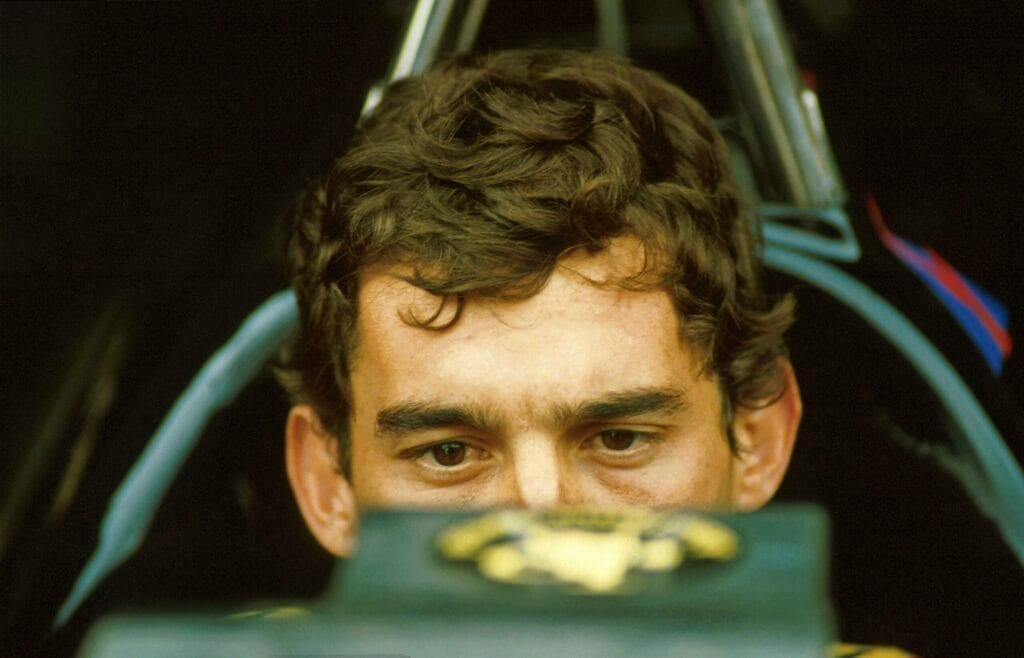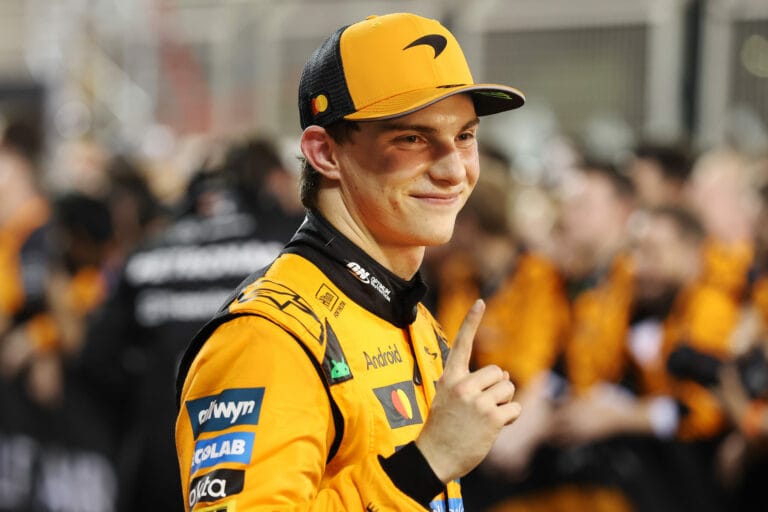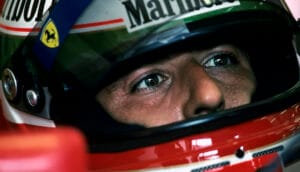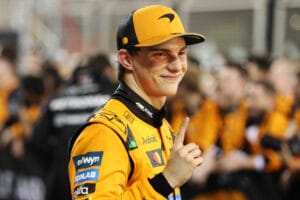Ayrton Senna, a legend forever. This Wednesday marks thirty years since the Brazilian passed away due to a severe crash on the Imola circuit. Today, we delve into Ayrton’s first victory, a veritable water ballet, in Formula 1.
Almost forty years ago, Ayrton Senna claimed his first Grand Prix victory. In 1985, he led from start to finish on the rain-soaked Estoril circuit in Portugal. Let’s revisit this memorable water ballet.
While the pole position doesn’t yield points or a cash prize, Ayrton Senna did receive a scooter on the evening of April 20, 1985. It was a marketing idea from sponsor Vespa to reward the fastest qualifying time with one of their products. However, Senna wasn’t particularly fond of scooters; the Brazilian preferred to explore the circuits on foot.
The previous year, he started in Portugal in third place. “And I finished the race in third place, so that promises something,” he said that evening. These were bold words for a driver who had only one Formula 1 season under his belt, but coming from Senna, they sounded convincing. His third place in 1984 was in a Toleman, not a car you win races with. Now, he was driving for Lotus, a team that hadn’t won a Grand Prix since Austria in 1982.
Downpour from the Heavens
Team manager Peter Warr saw the future in Senna. “It’s not a question of if he becomes a world champion, but when.”
Half an hour before the start of the race, it began to rain. However, the weather forecast predicted it would be a brief shower, so no hasty changes were made to the cars’ setup. The dry weather setting almost cost Williams driver Nigel Mansell and Alfa driver Eddie Cheever the race before it even began, as they spun off the track during the warm-up lap. They just managed to switch to the reserve car in time. And as it turned out, the rain didn’t stop, quite the contrary.
As the race begins, it’s pouring rain. Keke Rosberg fails to get off the line and is hit by Jonathan Palmer, resulting in a crumpled car and a sore wrist for the former.
Almost as bad off is two-time world champion Nelson Piquet, who, although he has a fine Brabham car at his disposal, has to make do with Pirelli tires.
His team boss Bernie Ecclestone has struck a lucrative deal with the Italians, but the Pirellis prove to be completely unsuitable in the rain. “I cursed Bernie for choosing Pirelli’s money,” Piquet recounts afterwards. The rain only gets worse. “I felt sorry for the other drivers because they had to overtake me while I could barely keep my car on the track. I was sliding all over the place.” Since Piquet falls a few laps behind, Brabham decides to use the race as a glorified tire test.
Piquet: “I even got out during a tire stop to put on a dry overall!” In the 29th lap, after four tire changes, he parks his car in the pits. It’s impossible to drive in the rain.
‘Senna Drives Smoother Than Others’
At the front, Senna seems to be the only one unaffected. After the start, he immediately pulls away from his teammate Elio de Angelis, who started fourth but immediately passes Rosberg and Alain Prost. The McLaren driver follows him closely, with Michele Alboreto’s Ferrari coming up behind. Visibility is minimal, even for Senna, who soon encounters backmarkers and is lucky not to collide with anyone. Mauro Baldi spins off the track in his Spirit, and when he re-enters the asphalt, he nearly torpedoes the Lotus. At Ligier, the team management decides to preemptively pull Andrea de Cesaris from the race, as he has spun so many times that an accident seems inevitable sooner or later.
Manfred Winkelhock, in the only remaining RAM – teammate Philippe Alliot spun out in the third round – watches in astonishment as Senna laps him time and again. “It was my worst race ever. I couldn’t even accelerate on the straight without flying off the track.”
They trudge along the soaked course at a snail’s pace, with only Senna, De Angelis, and Prost as exceptions. The latter two because they are fiercely battling for second place, Senna because he is Senna. Warr: “Senna drives smoother than others, uses less fuel, is easier on his brakes, and yet goes much faster than the rest. Incredible.”
‘Clearly, conditions are not safe’
The battle between Prost and De Angelis ends when Prost finally dares to overtake him on the straight. Although the Lotus has a higher top speed than the McLaren, Prost comes out of the last corner better. But as soon as he comes out of the slipstream, he hits a puddle of water and the McLaren spins around.
A dull thud against the guardrails and Prost is out. “I was driving almost 300 kilometers per hour and suddenly I had aquaplaning. I knew there were deep puddles on the straight, but I couldn’t see where they were because of the spray. And I had been driving behind Elio for so long that I had to pass.”
His teammate Niki Lauda, who himself dropped out with a burnt-out fuse, approaches the race management. “If even a top driver like Prost can’t keep his car on the track, it’s clear that conditions are not safe.”
Ayrton Senna’s Near-Crashes and Triumph
Ayrton Senna, despite his seemingly effortless laps, also had a few close calls with crashes. “I could hardly see anything when I approached a backmarker,” he shares after the race. “Even steering the car straight was sometimes nearly impossible, and once I almost flew into the wall on the straight. Luckily, I was able to regain control of the car. People think I was the only driver who didn’t make any mistakes, but that’s not true. I can’t even remember how many times I went off the track, it just never seemed to be caught on camera.”
At one point, Senna ends up in the grass at high speed with all four wheels, but he manages to get the car back on the track. Talent? “More like luck. I had completely lost control. I just happened to slide in the right direction and ended up back on the asphalt.”
Nearly a Minute Ahead
As far as Senna is concerned, the race should be stopped, although he waits until the 29th lap to signal to the race management: the minimum number required for points. But the race continues. Only when the two-hour time limit has passed, Senna is flagged as the winner of the Grand Prix of Portugal. He has almost a minute’s lead over Michele Alboreto, who finishes second. Patrick Tambay is third, to his own surprise.
“I’ve just been trying not to go off the track for two hours,” admits the surprised Renault driver. “If they had told me I was thirteenth, I would have believed it.” Senna’s teammate De Angelis finishes fourth.
As Senna crosses the finish line, he raises both arms out of the cockpit and abruptly lets off the gas. This surprises Mansell and Stefan Bellof, who are fighting for fifth place two laps behind him, so much that they almost crash into the guardrails. The Lotus mechanics, some of whom have climbed over the pit wall to celebrate the victory, are lucky they are not mowed down. In the pit box, Lauda shakes his head. “Senna is a great driver, but a little self-control wouldn’t hurt.”
Seatbelts Off in the Cool-Down Lap
Senna’s decision to unbuckle his seatbelts and wave to the crowd while half-standing in the car during the cool-down lap earns him a warning. The FIA also decides to ban team personnel from climbing over the pit wall. The traditional salute of the late Lotus team boss Colin Chapman, who passed away three years earlier, is thus a thing of the past: no cap will ever fly into the air again to celebrate a triumph.
But his successor Warr is not bothered by this. “I don’t aspire to follow in Chapman’s footsteps; they are too big for me. But I am glad that we have proven that Lotus can win races without Chapman.”
Ayrton Senna’s Humility After His First Victory
Following his first victory, Ayrton Senna displayed remarkable humility. He attributed his success to his ability to stay on track and lead the majority of the race, which gave him a better view than his competitors who were blinded by spray. However, Warr had a different perspective. He asked, “Why was Senna able to keep his car on track? Why was he faster than the rest? Because he is an exceptional talent. Every once in a while, someone comes along who is very special. I don’t know how to put it into words; it’s a talent you recognize immediately. I saw Senna in 1981 in Formula Ford and thought then: wow, we need to watch out for this guy in the future!”
Senna’s Complete Concentration
Warr praised Senna’s dedication, which would later become his trademark, and Lauda’s criticism of a lack of self-control did not last long. Warr stated, “A true champion never lets his thoughts wander from what he is doing. He is fully focused, and that’s why Senna could win. Others were just trying to keep their car on track, but he accepted the conditions and focused on his task to drive as fast as possible.”
Warr also recalled an instance that demonstrated Senna’s exceptional talent. “When a light came on in the cockpit for other drivers, they immediately came in to have it fixed. Senna tried to figure out how to solve problems while driving, without losing time with a pit stop. That’s what I call a great champion.”
Remembering Senna’s First Victory
- The very first victory of Ayrton Senna
- Jan Lammers’ Formula 1 adventure
- James Hunt: the last playboy racer
- Report: Bad boys in Formula 1
- Photos: The most beautiful liveries over the years
- Report: Jackie Stewart’s horror crash
- Hall of Fame: The most beautiful photos of the greatest champion









